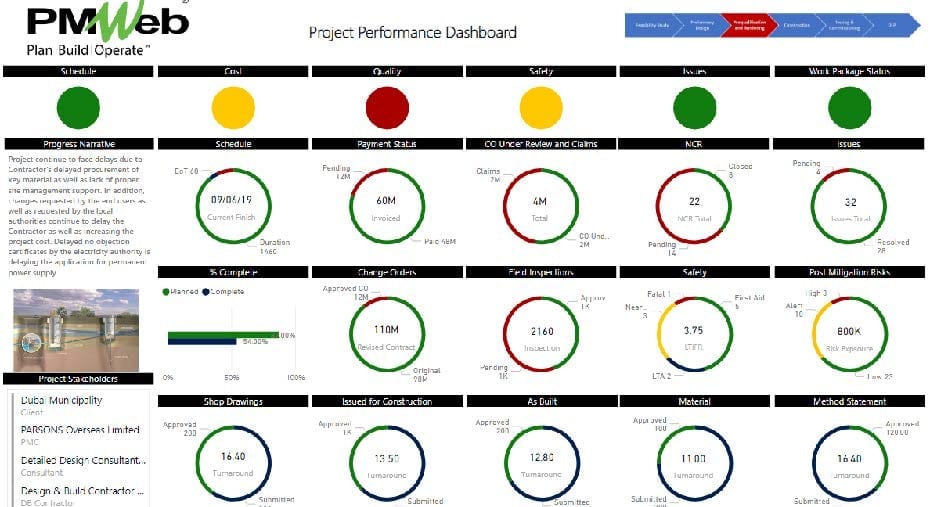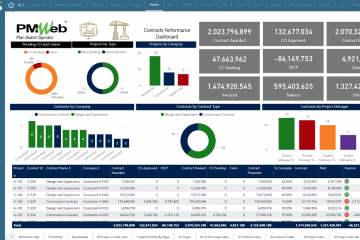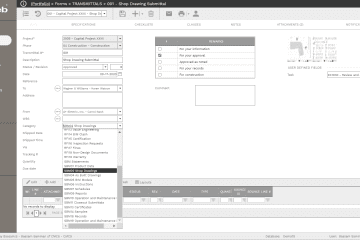The growing demand for transparency and accountability in delivering capital construction projects by public sector entities has enforced many of those entities to establish what is known as the Project Management Office (PMO) to manage, monitor, evaluate and audit the execution of those projects. To accelerate the setup of the PMO processes, municipalities, public works departments, ministries, and other public sector entities usually retain the services of a professional and experienced project management consultant (PMC) to establish and manage the PMO for a three-year period during which the PMC will provide hands-on training to transfer the knowledge for running the PMO to the newly established organizational unit. One of the key components of setting PMO processes, is to digitally transform the project management processes needed to deliver, monitor and evaluate the capital construction projects’ portfolio. This digital transformation requires the implementation of construction project management software, specifically a Project Management Information System (PMIS) within 3 to 6 months of commencing the PMO establishment process.
The implementation of the PMIS usually includes achieving three critical milestones. The first milestone is to have a consolidated list of all programs, projects and stakeholders that the public sector entity is currently involved with as well as all programs and projects planned for execution in the next three to five years. The second milestone is to digitally transform all construction site management processes that are being performed and managed manually using MS Word or MS Excel templates. Those usually include the processes for daily report, technical submittals (shop drawings, materials, etc.), safety incidents, written and verbal instructions, meeting minutes, work inspection requests, non-compliance reports among others. The third milestone is to digitally transform the contract and commercial processes which are usually managed by the public sector’s own finance department. Those include the processes of project cost estimate, budget, budget adjustments, awarded contracts, potential changes, change orders, interim progress invoices, invoices payment, final account and project funding.
The successful completion of those three milestones enables the public sector entity and the PMC consultant to decide of what other project management processes that the PMO needs to digital transfer. For example, the processes of design development, tender and award, health and safety, project closeout, risk and issues, sustainability among others could be digitally transformed if the Public Sector PMO has the requirement to manage. The establishment of the PMO and associated digital transformation along with the professional development tasks should be part of the continuous improvement roadmap for the PMO.
To achieve those three initial milestones within the very aggressive set dates requires selecting a Project Management Information System (PMIS) that has been specifically designed for managing the delivery of capital construction projects from a project owner perspective as the last thing a PMO wants to do is to reinvent the wheel. It further requires having a having a construction project management software solution that complies with regulations set for public sector entities such as storing all projects’ information on the entity own web servers, support of local language, whether it was Latin or non-Latin, fulfilling data security and access requirements among others. In addition, the selected PMIS should be easy to configure and implement by the public sector entity own PMO resources after the PMC contract comes to an end.
PMWeb is one of the project management information systems that was selected by many public sector entities across the globe to support the digital transformation of their capital construction projects’ portfolio. PMWeb comes ready with most of the processes, forms and reports that are common for managing capital construction projects as well as comes ready with a powerful visual form builder to create all other additionally needed processes. PMWeb supports all languages including non-Latin languages like the Arabic language as well as it is available as either SaaS or on-premise to fulfil the requirements for in-country data storage and security. In addition, PMWeb can be integrated with third party applications like those for accounting and enterprise resource project (ERP) which could be needed for the commercial management of capital construction projects. Finally, all of the data of the project management processes managed in PMWeb is stored in a single database, also considered as a PMWeb data warehouse to enable consuming the captured date by data visualization and business intelligence applications to provide a real-time single version of the truth monitoring, evaluation and reporting of projects’ performance.
Achieving Milestone No. 1: Projects Portfolio
There is no limit to the number of programs, projects and stakeholders that can be managed in PMWeb. Achieving the first milestone replaces using MS Excel as the tool for reporting the projects’ portfolio status with a trust-worthy, auditable and traceable register using PMWeb. To achieve this, the first step is to have a single repository of all stakeholders including the entity itself, end users, sponsors, project management consultants, design consultants, supervision consultants, contractors, subcontractors, suppliers, permitting authorities among others. PMWeb companies’ module is used to upload and store this information along with all supportive documents such as trade licenses, insurance, etc.
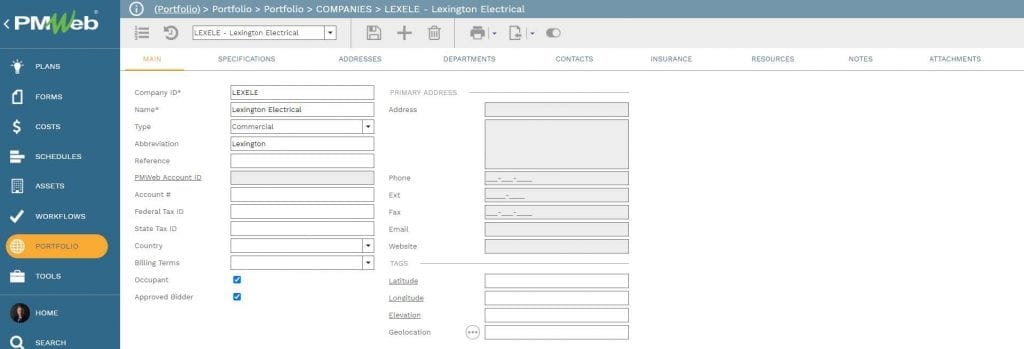
The next step is to upload all current, planned, terminated, on-hold and other projects that the PMO will be eventually responsible for. Although there is virtually no limit to what information that can be captured for each project, nevertheless great care needs to be given on what is available and what is important to report on. Information such as project name, location including the GIS location coordinates, stakeholders, status, budget, planned and actual start and finish dates, percent complete among others are important to capture.
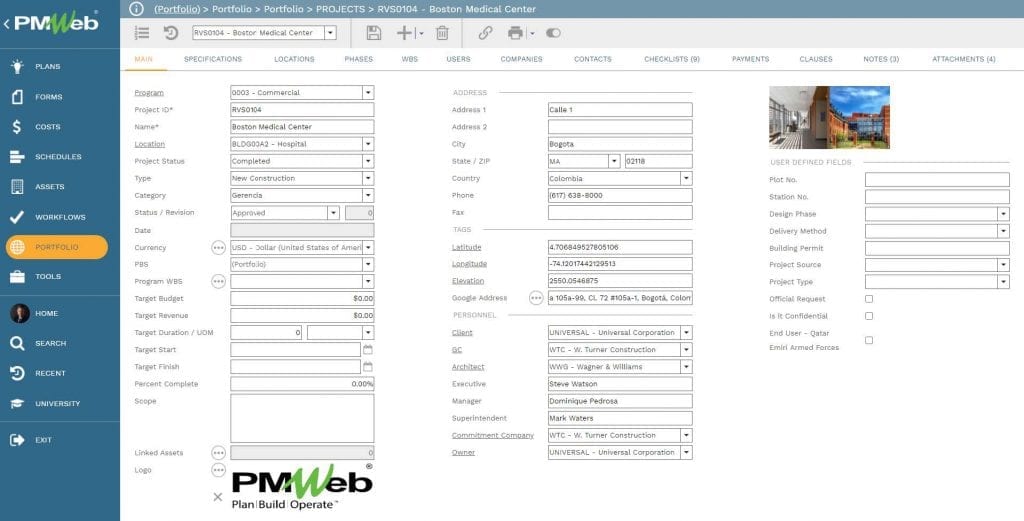
If there is a project in Oracle Primavera P6 or MS Project, this can be linked to the project where the dates and other related information are extracted from the imported schedule. PMWeb allows maintaining all versions of each project schedules including those for the baseline, revision and updates. This also allows comparing those schedule versions when needed.
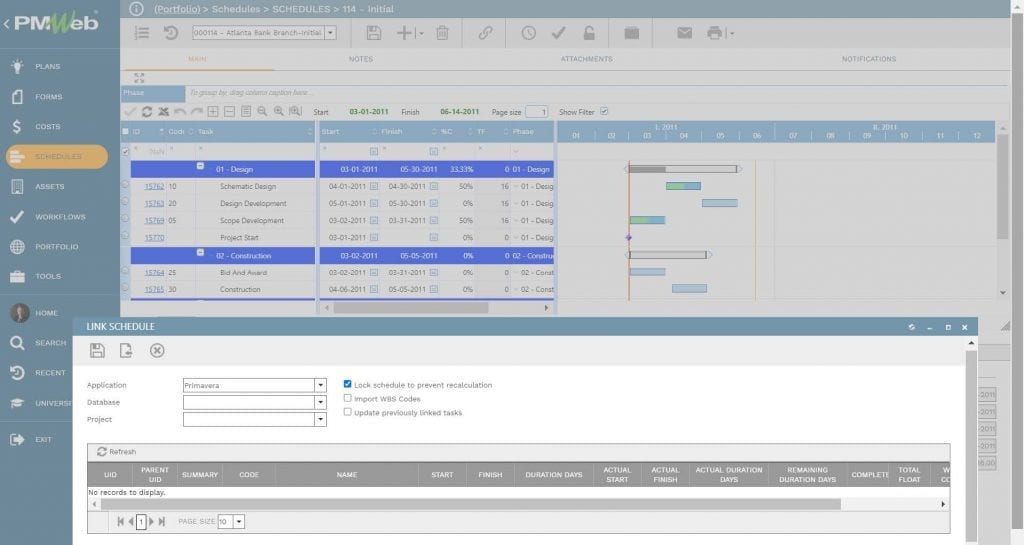
For each added project into PMWeb, attachments such as progress photographs, progress reports, awarded contracts and other documents can be either attached direct to the project or uploaded into PMWeb document management repository and then attached to the project. The latter is the recommended approach as creating the folder structure for filing documents for each project can be completed within the first milestone. In addition, hyperlinks to construction site cameras, if are in use, can be added to each project.
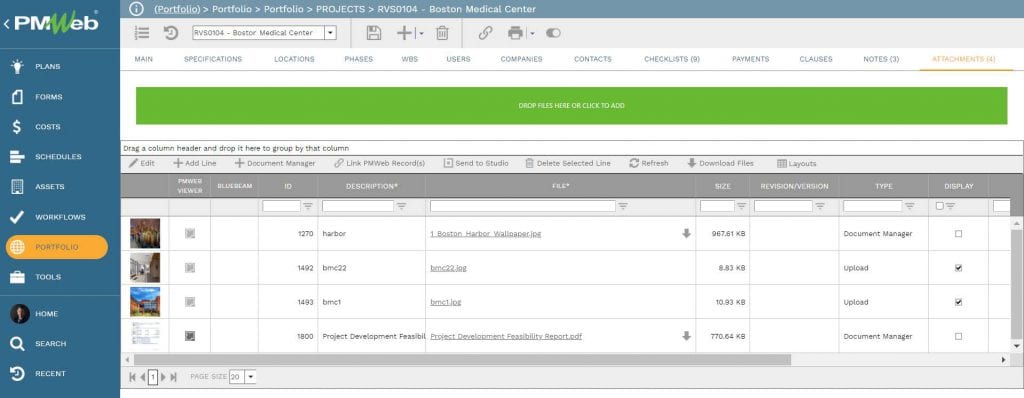
This captured information provides the PMO with a real-time single version of the truth of all capital construction projects’ portfolio that the entity has as today. The list of projects can be grouped, sorted, summarized and filtered using the many projects’ data fields captured in PMWeb. The summarized data can be displayed in different types of visuals to provide the needed quick insight for the report reader. The scorecard of the projects’ list could have red, cyan and green colored indicators to highlight the performance status of each project. Those projects can be visualized on an interactive map using the given GIS locations with the option of also displaying the boundaries of those projects if the relevant shapefiles are provided from ESRI GIS.
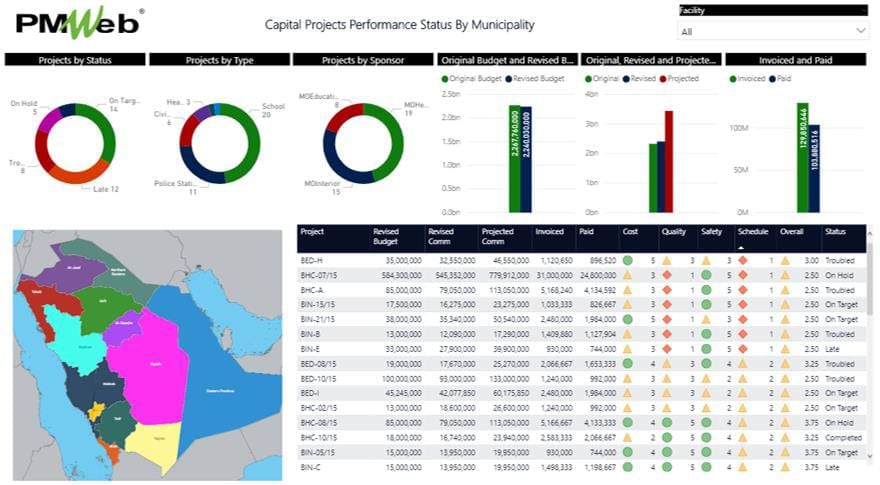
Achieving Milestone No. 2: Construction Site Administration Processes
The first step in the digital transformation of site administration processes is to define the document filing structure for each project. PMWeb document management repository is used to create the folders and subfolders needed to upload and store project documents. This enables setting the permission rights to edit or view each folder attributes specific to each folder and who should be notified when a new document is uploaded, downloaded or deleted as well as when a new document version has been uploaded. PMWeb allows uploading all file types with the option to restrict what file types that cannot be uploaded as well as set the size of each uploaded file which is usually set at 250 MB per file. For completed projects, PMWeb allows archiving and exporting those document folders and documents within each folder in a format that can be easily saved and stored by the PMO.

The next step is to configure PMWeb readily available processes to be used on the projects. Those would usually include safety incident, daily report, submittal, RFI, punch list, transmittals, meeting minutes, drawings and contract documents register and correspondence. PMWeb allows adding unlimited number of user defined fields to those readily available processes as well as defining list of values that each form can select data from for categories, types among others.
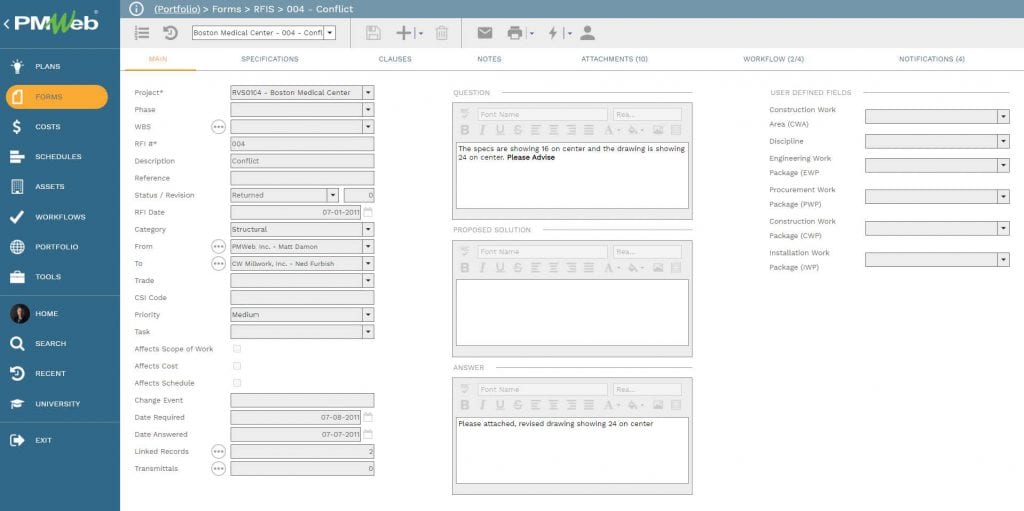
In addition, PMWeb visual custom form builder is used to create all additional site management processes including the option of replacing the ready to use processes that PMWeb already have and detailed above. Those custom forms are designed to include all fields and tables needed for each site management process to be managed by the public sector entity. Those processes include work inspection request (WIR), non-compliance report (NCR), site work instruction (SWI), confirmation of verbal instruction (CVI), executive progress report, gate pass, permits to work among others.
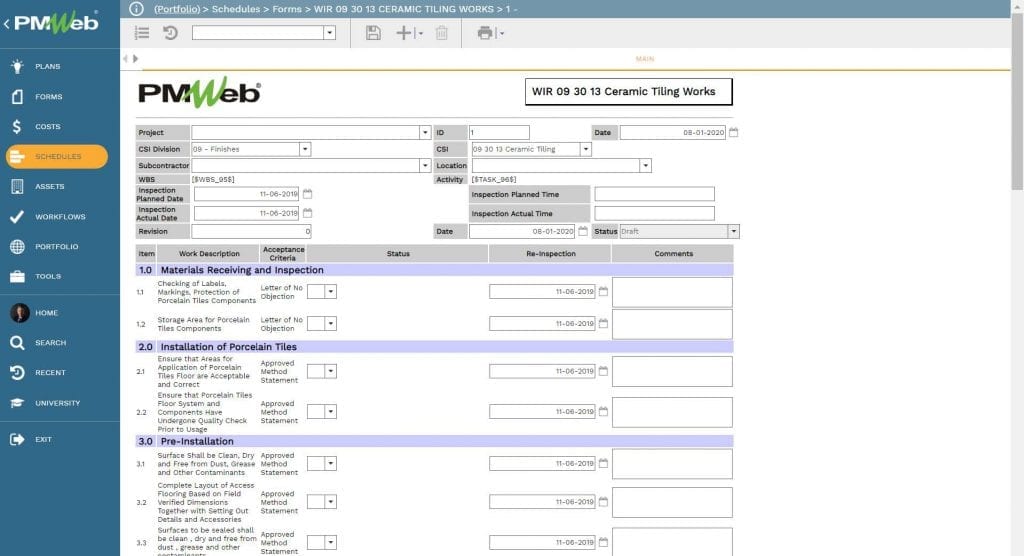
For each construction site management process, a workflow is assigned to map the submit, review, approve or reject steps. The workflow defines the duration and sequence of tasks to be performed by the different project team members as well as review actions permitted at each workflow step. The workflow could include conditions to ensure that the approval authority levels are adhered to. In addition, the workflow could define alerts level for delayed workflow steps. The workflow coupled with the access rights configuration by project role enables real-time collaboration among all project stakeholders including the PMO, PMC, supervision consultant and contractors.

Since there will be a need to formally communicate many of those processes with design consultants, supervision consultants, contractors among others, an output form needs to be designed for those processes. Those output forms can be designed in any desired format to meet the public entity branding requirements. This enables printing the form, wet sign and stamped the form, then scan and upload the form into PMWeb document management repository. As an alternative, PMWeb also offers integration with DocuSign to enable using digital signature on output forms as well as workflow steps.
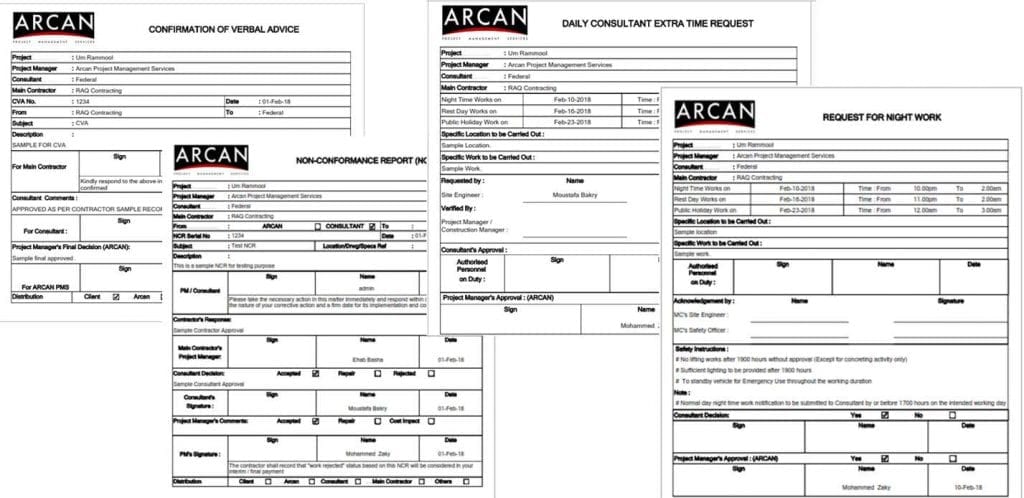
Tabular and graphical reports can be created to monitor, evaluate and report the performance of each construction site management process. In addition, a consolidated report can be created to report the performance of all construction site management processes for which the information will be further summarized in the project dashboard when it is created.
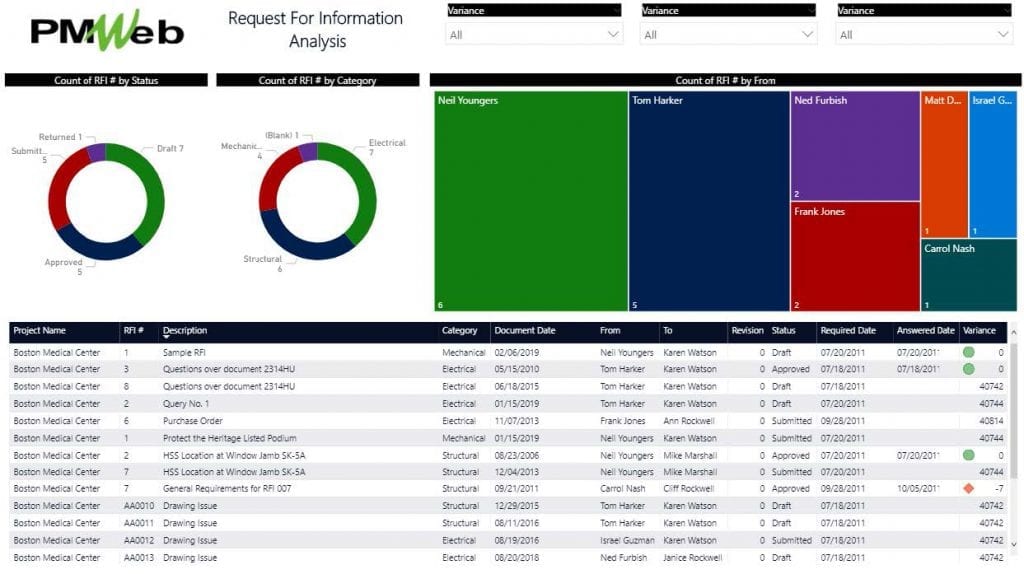
Achieving Milestone No. 3: Contract and Commercial Management Processes
One of the unique offering of PMWeb is that it comes ready with all the processes needed to achieve the contract and commercial management processes. Those include setting the cost breakdown structure, cost estimate, budget and budget spending projection, budget adjustments and transfers, awarded commitment contracts, potential change orders including request for change, engineer’s instructions, extension of time, claims among others, change orders or agreed variation instruction, joint measurement report, interim progress invoices, miscellaneous invoices, timesheets, actual payments of invoices, funding sources and funding sources. All those processes could be assigned with its own workflow steps as well as attach all supportive documents. Nevertheless, what is more important that all off the contract and commercial information can be summarized and displayed on a single report known as the cost worksheet. PMWeb, as a leading construction project management software, allows creating unlimited number of cost worksheets which can include in addition to the standard cost data fields, additional fields that can be calculated using mathematical formulas.
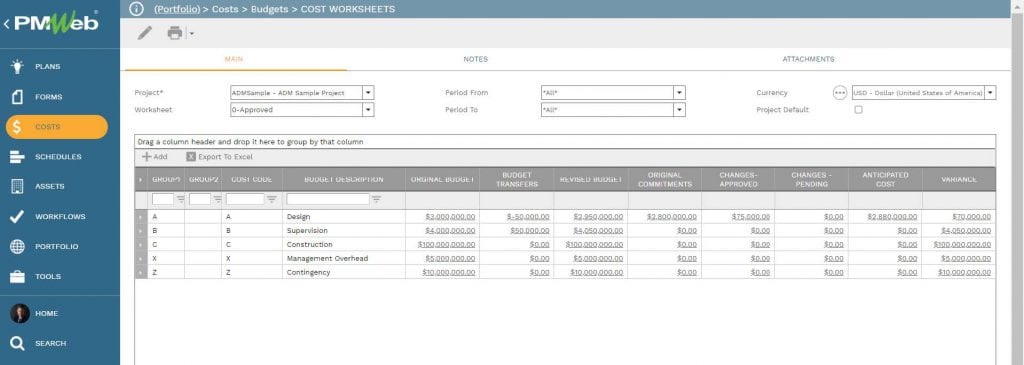
Similar to all other PMWeb processes, tabular and graphical reports can be created to report on each project as well as group projects or program of projects financial performance status. Reports can display the cost performance status to the desired cost breakdown structure as well as group cost data to provide an oversight of approved budgets, approved budget spending, awarded contracts, potential change orders, change orders, invoiced amount and payment of approved invoices.
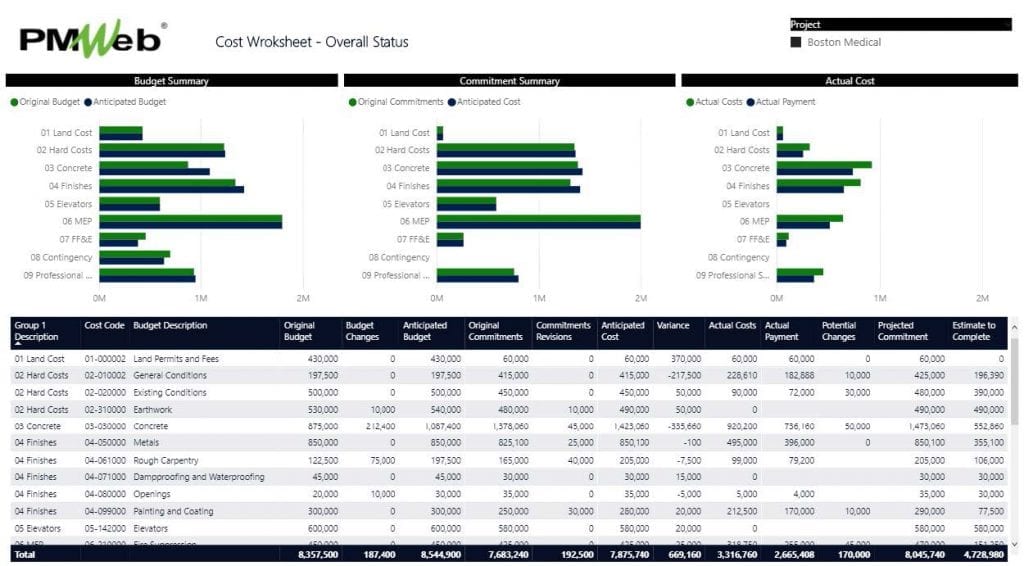
Putting It All Together
The information captured in the PMIS during those three milestones becomes the basis for provide the public sector entity and the PMO with a real-time single version of the truth performance report. The report is based on trust-worthy data that is auditable and traceable.
